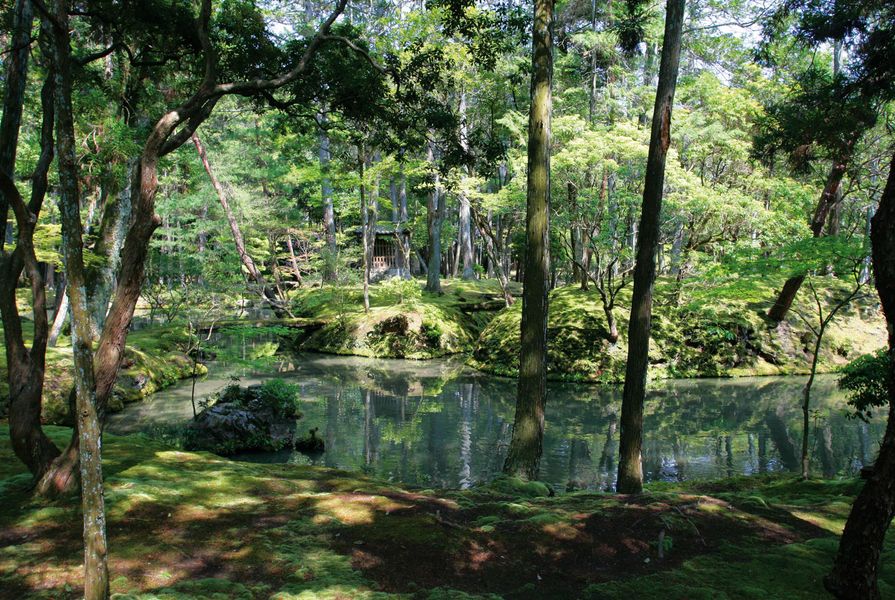“In our first moments within the walls, we sense that we’ve arrived at the most beautiful place in all of Japan.” After chancing on a description of Saiho-ji in a travel story about Japanese gardens, I knew that I would follow author Nicole Krauss to Kyoto. Krauss toured Japan seeking inspiration for her tiny New York backyard. Her search climaxed at Saiho-ji, known locally as Kokedera, the moss temple. Here, within a walled garden, a unique and fragile landscape of mosses unfolds around a central pond.
Home to Japan’s most famous and revered Zen gardens, from the mystical stone garden of Ryoan-ji to the mirrored pools of fourteenth-century Tenjuan, Kyoto has long been a place of pilgrimage for landscape enthusiasts. So what was it that Krauss found unique in Saiho-ji? The suspense builds weeks in advance, as I await the required formal letter of invitation from the temple. I fly to Tokyo, then make my way west via the high country of Nagano to coastal Kanazawa, and then south to Kyoto. At the appointed hour, I hurry to the temple complex, located on the city’s western fringe and nestled within the low wooded hills of the historic Arashiyama district. But before I am allowed to view the garden, I am ushered into the main temple with the other visitors, where we kneel awkwardly on tatami mats in front of low desks. Accompanied by drumming, robed monks chant a solemn sutra, which we are then instructed to trace out on translucent paper using brushes dipped in watery charcoal ink – an impossibly delicate task for the uninitiated. Like Krauss before me, I finish early to buy a few seconds alone in the garden.
Passing through a gate in the garden wall, I enter a world of tranquil pools and bird calls. Sunlight falls through branches and dapples the moss carpet beneath, creating a pleasing reciprocity between the play of shadows from above and the patterns of moss below. The carpet continues to the verge of a central pond, where koi cloud the depths of the grey-green water. There are reputedly over 120 types of moss in this garden: moss growing round and sponge-like between tree trunks; plush tufts and soft folds of moss; some with tiny distinct leaves, some slick, furry or hairy; all in subtly shifting shades of green. Occasionally moss climbs the trunks, but it is mostly kept off. Here and there gardeners sweep the moss with straw brooms, gathering fallen leaves in woven baskets. The clumps of moss often seem to be alive and ever-so-slowly moving. This is a carefully tended landscape, not tortured and shrunken like bonsai, but free and joyously growing everywhere.
The Saiho-Ji moss garden in Kyoto, Japan.
Image: Imogene Tudor
In between 1339 and 1344, Zen monk Muso Soseki began the arduous task of restoring Saiho-ji and converting it into a Zen monastery. Enlarging the existing pond to form the kanji character for “heart,” Muso wrapped a circuitous path around the pond without viewing platforms, rest spots or seats. Zen gardens had evolved as static objects of contemplation, out of reach and seen through controlled vantages from a deck or while seated indoors. Concealed from the temple by high walls, Muso’s garden offers no place to sit and contemplate. Instead, the act of meditation is enacted by walking. The prototypical promenade, this innovation would give rise to famous Japanese gardens such as the Imperial Villa Katsura and Kenrokuen, and arguably Place des Vosges and Versailles. In a departure from the symmetrical Shinden-zukuri style, pavilions and tea houses were arranged around the path in accordance with the undulations of the terrain, the first deliberately asymmetrical layout of buildings found in Japanese architecture. In the sloping ground above the pond, Muso created a second, and perhaps even more significant, garden. While the lower garden was intended for public view, the upper garden was the exclusive domain of the monks. Here, in concert with the wilder and rockier terrain, carefully chosen rocks are arranged in frozen waterfalls or gathered in radiating terraces to suggest monumental landforms. Muso’s playful and profound idea of using fragments of nature to evoke vast landscapes ushered in the age of the dry Zen gardens of rocks and raked gravel, which would reach its apotheosis at nearby Ryoan-ji and Daitoku-ji.
Muso never planned the cause of Saiho-ji’s present fame and beauty and his pond garden was actually covered in white sand. Early in the Meiji period (1868–1912), the monastery lacked sufficient funds to maintain its grounds. Successive floods inundated the garden, and the moss which grows today in such incredible abundance was caused by accident rather than design. In his book Reading Zen in the Rocks, François Berthier describes the moss as “parasitical vegetation.” However, rather than undermining the qualities defined by Muso, the moss growth enhances the garden in a particularly Japanese way. To Westerners, moss is often associated with undisturbed nature, because its presence is associated with inertia. This is why the expression “a rolling stone gathers no moss” is so frequently misinterpreted. While the moss at Saiho-ji is not as ancient as the garden, it has been carefully tended for almost two hundred years. Moss doesn’t survive being walked on. It is a fragile construction very much like the raked gravel of the typical Zen garden. The accretions of age, the additions and changes of various periods and chance occurrences are what gives the Japanese garden its special nuances. “What is accidental, we find ourselves wondering, and what is deliberate,” muses Krauss in her article. Her question touches the very essence of the Japanese garden.
Source

Project
Published online: 1 Feb 2010
Words:
David Neustein
Images:
Imogene Tudor
Issue
Landscape Architecture Australia, February 2010


















